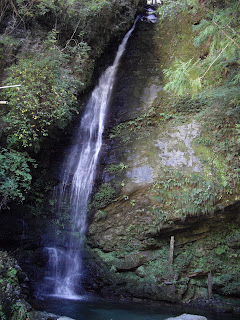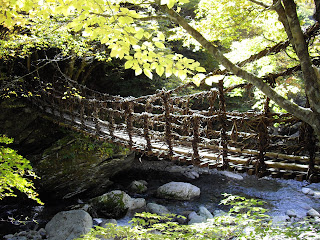 The drive towards Iya valley got interesting after Ikeda and the road was dotted with a mixture of the old and the new. Dilapidated and abandoned houses that seemed on their last legs stood side by side with modern sleek double storied mansions.
The drive towards Iya valley got interesting after Ikeda and the road was dotted with a mixture of the old and the new. Dilapidated and abandoned houses that seemed on their last legs stood side by side with modern sleek double storied mansions. As we drove deeper into the valley along the river the traffic was reduced to the occasional car every 10 minutes along the windy single lane mountain road. The drive towards the Iya campground was very beautiful. From the car we had views of the emerald waters of the Iya river flowing over boulders below while on either side of the road, the mountains rose in near vertical formation and were covered in early morning mist, shrouding the whole experience in a mystical beauty. The autumn colours danced along the tops of the mountains making the valley appear as if it were blushing. The mist lifted and the sun finally came over the peaks and warmed up the hitherto frosty air making the whole valley come to life.
The beauty of the valley was soon interrupted by the inevitable encroachment of the concrete jungle and tour buses as soon as we went past the famous pissing boy statue and headed into East Iya.

There is a beautiful waterfall 200m down the road from the vine bridge but the whole experience is stained by all the cigarette butts and other tourist trash lying around the area. We got out of the area as fast as our little hire car could take us.
As we drove deeper into the valley and towards Oku Iya, there was the inevitable road construction going on. Every small mountain road in Japan has a team of construction workers doing what appears to be quite unnecessary road works. In this case, the sight of gravel filled dams that are testament to government waste in Japan nearly made our eyes water. Iya is a spectacular place with amazing natural beauty, but years of bureaucratic bungles are bringing it to the brink of destruction in some areas.
Once we continued even further into the valley,we got a sense of the natural beauty again. However, there really are a lot of dilapidated houses on this particular stretch of road. It is not quite a ghost town, but the sense of decay and depopulation permeates the hamlets dotted along the road echoing the fact that Japan really is an ageing island.
We saw a remarkably sad symbol of nostalgia for the way things used to be when we came across a household that had created a whole mini village of stuffed life size people in their rice field. 
Once, the Iya valley like many places in rural Japan, bustled with life and families. All that is left are the desolate houses and myriad of dams and other unnecessary infrastructure. No wonder the children leave, when their once proud and beautiful river becomes a concreted ditch they realise they might as well live in the concrete city where there are more opportunities with similar views.
It was refreshing then to come across the double vine bridges of Oku Iya (奥祖谷二重かずら橋) which are a lot less touristy and due to their remoteness, less crowded as the tour buses rarely venture this far into the valley.
The entry fee is 500yen which allows unlimited crossings on either of the two bridges (one is male and one is female, the difference being size) and also the yaen which is a cargo pulley cage for ferrying people and goods across the river.
The autumn colours were shining into the rushing river, and we enjoyed the sway of the vine bridge across. The fact that the vines had steel reinforcing didn’t change our experience or sense of the tradition at all.
The added bonus with the ‘Yane’, which was used to transport heavy goods across the river in days gone by was really fun. It is now a simple ride where you sit inside and pull yourself across.
The experience was enjoyable, wholesome, good fun minus the crowds, but don’t wait to visit! At the time of writing, the Oku Iya was building a brand new ticket office and some facilities, and the company had recently completed a carpark area large enough for a tour bus. It won’t be long and this too will succumb to the tourist infestation.
Overall, I enjoyed the experience in the Iya Valley for the rich memories of extravagantly beautiful landscapes, however it is a complicated affair, and unless the Japanese government and the Iya valley residents choose to manage their resources better, it will soon have next to no pockets of beauty left to treasure.








No comments:
Post a Comment